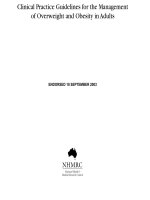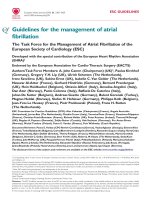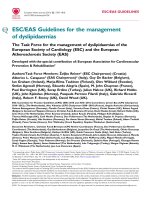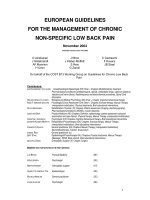Research and development guidelines for the food industries
Bạn đang xem bản rút gọn của tài liệu. Xem và tải ngay bản đầy đủ của tài liệu tại đây (14.38 MB, 172 trang )
RESEARCH & DEVELOPMENT
GUIDELINES
FOR THE FOOD INDUSTRIES
Wilbur A. Gould, PhD.
Food Industries Consultant,
President
Midwest Food ProcessorsAssociation,
and
Emeritus Professor of
Food Processing & Technology
The Ohio State University
RESEARCH & DEVELOPMENT
GUIDELINES
FOR THE FOOD INDUSTRIES
COPYRIGHT@1991 CTI PUBLICATIONS, INC.
Baltimore, Maryland
All rights reserved. No part of this book may be
reproduced or altered or utilized in any form or by any
means, graphic, electronic or mechanical, including
photocopying, recording or by any information storage
and retrieval system, without permission in writing from
the copyright owner. Inquiries should be addressed to:
CTI Publications,
261 9 Maryland Ave., Baltimore, MD 21 21 8-4576
Printed in the United States of America
Library of Congress Catalog Card Number 91-72707
ISBN Numbers are as follows:
0-930027-1
7-5
Cover photo (top) courtesy of Carnpden Food 8 Drink Research Association
While the recommendations in this publication are based on scientific studies and wide
industry experience, references to basic principles, operating procedures and methods, or
types of instruments and equipment are not to be construed as a guarantee that they are
sufficient to prevent damage, spoilage, loss, accidents or injuries, resulting from use of this
information. Furthermore, the study and use of this publication by any person or company is
not to be considered as assurance that a person or company is proficient in the operations and
procedures discussed in this publication. The use of the statements, recommendations, or
suggestions contained, herein, is not to be considered as creating any responsibility for
damage, spoilage, loss, accident or injury, resulting from such use.
CTI PUBLICATIONS Inc.
261 9 Maryland Ave., Baltimore, MD 21 21 8-4576USA
301 -467-3338FAX 301/467-7434
PREFACE
Research and Development (R & D) is of major concern to
nearly all aspects of the food industry. R & D is an essential part
of most agricultural college programs. Further, R & D is part of
nearly all graduate students studying in the food science, food
technology, food processing, and food related programs. Lastly, R
& D is of vital interest to the public at large and, of course, the
ultimate consumer of the fruits of R & D.
My interest is putting this book together was developed
because of necessity as my advisors, teachers, and peers always
talked about research and development, but seldom got down to
the 5 W’s and 1 H, that is, the why, the when, the where, the
what, the who, and the how. My advisor and many of my teachers
left it up to me and my colleagues to find out who was doing
research and development work, what topics were considered
worthy of good research in the field, when was the work done,
where was the information published, why was a given approach
taken, and how were the results being utilized in the industry. I
was totally appalled by the lack of good resource material and
pertinent information. Further, I could not fiid good and sound
research methods that fit the situation that I was always
interested in. Therefore, after much consternation and thought, I
developed an R & D course of instruction for the graduate
students interested in my area of expertise and the thoughts in
this book reflect some of the things that I gleaned and shared with
these students as we struggled through some 40 years of research
in food processing and technology. Many of my graduate students
have shared with me much information in this book as they have
worked in both academia and the food industry. They are the ones
that made this book come to fruition and they are the ones that
suggested I document my thoughts for those who follow,
My most sincere thanks to my former students, my many
collegeaues, and my many friends in the food industry for their
helpful suggestions, criticisms, and inspirations. I particularly
wish to thank Winston Bash, Ken Beck, Ron Gould, Bill
Hildebolt, Jackie Hood, Jim Mavis, Wade Schulte, and Bill
Stinson for their critiquing this manuscript and their helpful
suggestions. My special thanks to Art Judge, II and Randall
Gerstmyer for their constructive comments, interest, cooperation
and valued assistance.
Wilbur Gould
ABOUT THE AUTHOR
Wilbur A. Gould was reared on a farm in Northern New
Hampshire. He received his Batchelor of Science degree from the
University of New Hampshire in Horticulture-Plant Breeding. He
started his graduate work at Michigan State University prior to
service in the U.S. Navy during World War II. After military
service, he completed his Master of Science and Ph.D. degrees at
The Ohio State University.
Dr. Gould retired from The Ohio State University after 39 years
on the faculty as Professor of Food Processing and Technology.
He taught 9 courses during his tenure and advised over 900
undergraduate students, 131 Master of Science Students and 76
Doctoral students. His major research interests were in Vegetable
Processing and Technology and Snack Food Manufacture and
Quality Assurance. He has authored some 83 referred journal
research publications, over 200 Food Trade articles, and 9
books.
Dr. Gould is a Member of Phi Kappa Phi, Phi Sigma, Phi Tau
Sigma, Sigma Xi, Gamma Sigma Delta (Award of Merit in 1984),
Alpha Gamma Rho, Institute of Food Technologists (Fellow in
1982), and American Society of Horticultural Science
(Distinguished Graduate Teaching Award in 1985).
The following are some of the recognitions that Dr. Gould has
received The Ohio State University Distinguished Leadership to
Students Award in 1963 and a Certificate of Recognition Award in
1986; Ohio Food Processors H.D. Brown Person of Year Award in
1971; Ohio Food Processors .Association Tomato Achievement
Award in 1985; Ozark Food Processors Association Outstanding
Professional Leadership Award in 1978; 49er’s Service Award in
1979; Food Processing Machinery and Supplies Association
Leadership and Service Award in 1988; Ohio Agricultural Hall of
Fame in 1989 and an Honorary Life Membership in Potato
Association of America in 1990.
Dr. Gould presently serves as Executive Director of MidAmerica Food Processors Association, Food Technology
Consultant to the Snack Food Association, Secretary-Treasurer of
The Guard Society, and Consultant to the Food Industries.
Dr. Gould’s philosophy is to tell it as he sees it, be short and get
right to the point.
1
Chapter 1
RESEARCH AND DEVELOPMENT
AND ITS ROLE IN THE
FOOD INDUSTRIES
"Research is to see what everybody has seen and to think
what no body has thought" A. S. Gyorgyi
The food industry is continuously confronted with problems and
concerns for its processes and its products. Consequently, great
opportunities exist for future actions to improve the position of
any given firm within the industry through research and
development (R & D). Some of the present day major concerns
include the following:
AUTOMATION - Development of programs, equipment, and
application to insure greater on-line efficiencies, better product uniformity, and a reduction of costs.
BIOTECHNOLOGY & BIOENGINEERING
and new processes.
- New products
CONSUMERISM - Dealing with Activists Groups and their
wants, the changing eating habits and patterns, Dietary
needs, Weight control, etc.
ENVIRONMENT - Air pollution, solid and liquid wastes.
FOOD SAFETY - Uses of chemicals for production agriculture,
food additives, chemical cleaners, micoorganisms, etc.
LABELING ISSUES
etc.
- Nutritional and other claims, quality,
2
RESEARCH & DEVELOPMENT GUIDELINES
LABOR - Lack of trained and skilled and scientific, costs and
benefits including health care and insurance.
NEW PRODUCTS - Modifications, reformulations and new
creations.
ON-LINE SENSORS AND CONTROLLERS - Identification of
product quality during manufacture and for assurance of
total quality control.
PACKAGES AND PACKAGING - Metal, vs glass vs plastic
vs composities and product liabilities, insurance,
disposal biodegradable, microwaveable, retortable and
shelf life.
PROCESS CHANGES - Aseptics, Can Acid by acidification
and refrigeration.
QUALITY - Its identification, assurance and evaluation
ramifications including analytical instrumentation shelf
life testing, nutrition, and consumer education.
RAW MATERIAL COSTS - Urbanization, drought, irrigation,
and out of country produced.
REGULATIONS - Their effect on development of new chemicals and their testing and on food plant operations including marketing of foods.
RISK/BENEFIT CONCEPTS - Lack of definition and ultimate
effect on slowing down of research and marketing of new
products and new additives.
SOLID WASTE DISPOSAL - Organic and inorganic chemical
problems, including digestion times and use of mice
organisms.
LABELING - Nutrition, quality/grade identification including
consumer education.
R & D/ROLE IN THE FOOD INDUSTRY
3
Need for Research
More money is spent on food today than any other single
consumer item. Yet, the food industry as a whole spends less
money on research and development than any other industry.
Some industries spend well over 20% of their gross dollar income
for research and development while the latest figures indicate that
the food industry does not even spend 1% on research and
development. However, some companies spend a lot of money on
research and new product development in their firm. Much of it is
tied in with quality assurance, production programs, processing
changes, marketing practices, etc. and not under an R & D
Department or funds per se. In 1979 NSF published that the
continuing rate of return to the gross national product for every
dollar invested in R & D was 30 to 50%. This was for all
industries. The return on dollars spent on R & D for the food
industry may be higher or lower depending on the product and the
firm. There is no question that R & D dollars over the long run
should make for a good return on the investment if research is
properly conducted with the results put into practice.
If one goes back in history and looks at some of the b t real
efforts to solve food problems, one has to take a look at the early
1800’s and Napoleon Bonaparte and his offer of 10,OOO Francs for
the development of a method of food preservation. Bonaparte
could only move his armies as fast as he could move his food
kitchens as an army moves on its stomach. Today, the highest
award by the Institute of Food Technologists is the Nicholas
Appert award as Appert was the man that won the 10,OOO Francs
for his method of food preservation in 1810, that is, the concept of
hermetically sealing food in a container followed by sterilization.
What is Research?
Progress as we know it today would not be possible without
research. Boss Kettering stated “If you don’t do research until you
have to, its too late”. This statement has been most true and
many segments of the industry now realize the importance of a n
on-going research and development program. Some segments of
the industry allocate funds direct for contract or in-house research
4
RESEARCH & DEVELOPMENT GUIDELINES
and development. Most food firms today realize that the consumer
wants new types and styles of different formulated foods. Change
should be made in some cases in the food industries to make food
better.
Right after World War 11, the U. S. Government passed the
Hatch Act and established a n elaborate system of funding agricultural research. Other agencies like the National Science
Foundation, also, sponsored research in food and agriculture.
Presently, private industry funds much of the research in the food
areas. In addition, due in part to mergers, many companies have
established elaborate R & D departments and do much of their
research inhouse. Research in the food areas is a major part of
the over 50 Universities around the US where food science and
technology programs are offered. Faculty and graduate students
do food research and development work as part of their work load
or graduate training.
Paul Hudson, former Dean of the Graduate School at The Ohio
State University once stated that “research is evidence of creative
urge and dissemination of information is the human trait of
communication”. To me this is most relevant and it truly depicts
the ideal type researcher. Too many people call themselves r e
searchers, but they show little creativity and only communicate as
little as need be to get by. Any one aspiring to be a researcher
must be creative and they must want to contribute to man’s
knowledge. Research in its simplest definition is doing those
things that help build or advance existing knowledge. Research in
the food industries should go beyond this and reduce costs of food
production, costs of food preservation and costs of marketing the
food supply. Research should strive to improve product quality,
nutrient retention, and the shelf life of our food supply. Research
in the food industries should develop new products, processes, and
systems of preservation to continue to satisfy consumer wants.
New products are needed today to satisfy the changing life style
needs, to provide food for the large change in ethnic population,
and to meet the needs of the changing demographics, that is,
teenagers, the YUPPIES, and the increasing number of the
elderly. The food industry should look at research as their road to
the future not just to solve short term goals.
R & D/ROLE IN THE FOOD INDUSTRY
5
The Scientific Method
We learn new fads and ideas by chance, by trial and error, and
generalization from experience and by logic, that is, reasoning
things out or by using the scientific method of inquiry. The
scientific method is an orderly system of search for the truth.
There are six fundamental steps to be followed:
1st step -Identify the problem, establish the objectives or develop
the hypothesis, that is, the ‘‘why”
2nd step -Find out “what” has been done to-date, that is, start
with a library search of the literature, patents, etc.
3rd step -Develop a procedure or establish the approach to solve
the problem, that is, the “how” to do it.
4th step Collect the data or gather the fads, that is, work the
plan.
5th step -Interpret the data to find the solution to the objectives or
test the hypothesis.
6th step -Develop conclusions, make recommendations, and summarize your efforts.
Research is accomplished by people with inquisitive minds
seeking the truth and new ideas and concepts, hopefully, to
improve the food industry and all foods for mankind. Research
may be very basic, that is, understanding the fundamentals of
change or the reasons why things are different from one another.
This in the past was accomplished by Federal and State agencies
and many non-profit educational and institutional research organizations.
Research may be very practical or applied, that is, determining
the best usage for any given tomato variety. Generally, basic
research in the food industry is left to the food scientist whether
he or she be in academia as a candidate for the Ph. D. degree or a
staff member in an R&D laboratory in the food industry. This
kind of research is needed to build a base from which to make
application by the food technologist to the food industries. The
technologist applies this basic research to solve industry problems.
6
RESEARCH 8z DEVELOPMENT GUIDELINES
Product or process development research can be both basic and
applied depending on what is being attempted. Development of a
new food additive would be basic research while the application of
an additive to given food items would be applied research. Many
researchers do both types of research and they do not distinguish
between either term. Frankly, I think too much has been written
and made over about these terms in the literature and I think its
high time we describe them both as those things that we diligently
do to search for the truth or new knowledge to solve the problems
of the food industries. From a researchers standpoint, problems
are opportunities and that’s the way I look at food researchopportunities to help the individual food firm help itself to stay
ahead of the competition.
Some Research Objectives
The following are some broad areas that may be a part of the
objectives or reasons for establishing and R & D program or
department
1. To solve existing problems and nuisances in connection with
materials, methods (processes), machines, finished products, services (manpower) and environment and to anticipate and prevent
such troubles from occurring in the future.
2. To reduce costs involved in the use of materials, processes,
products, and services.
3. To improve the quality of existing materials, products, processes and services.
4. To develop new products, new line extensions, or new uses
for exisiting materials, products, processes, and servcies.
5. To develop suitable substitutes for existing materials, products, processes, and services.
6. To develop uses for waste materials thus, creating new byproducts.
7. To keep the firm abreast of scientific and technological
knowledge in areas of vested corporate interests.
R & D/ROLE IN THE FOOD INDUSTRY
7
8. To establish, issue, and maintain standards and sped%
cations for all incoming materials, products in process, and
finished packaged products bought and/or sold by the firm.
9. To represent the firm in matters involving regulatory, scientific, and technological matters including labeling, nutrition, standards, waste disposal, and environmental matters.
10. To develop educational programs to maintain and improve
consumer relations.
11. To assist the management of the food firm on long range
plans and opportunities.
12. To improve the return on vested capital and on unit sales
volume by increasing product qualities at the lowest possible
costs.
Figure 1-1
SOURCES OF INFORMATION
A. Text Books
B. Meetings/Conferences/Workshops/Seminars
C. Scientific Journals
a. Primary or original works with experimental procedures
and data-Peer Reviewed
b. Secondary publications
1. Abstrads
2. Reviews
3. Nomographs
4. AnnualReports
5. Advances in .....
6. Symposia
8
RESEARCH & DEVELOPMENT GUIDELINES
Figure 1-1 - Continued
D. Patents including foreign
E. Master of Science (M. Sc.) Thesis and Doctor of Philosophy
(Ph. D.) Dissertations
F. Translations of foreign works
G. Trade Publications
H. Association Newsletters
a. National and International
b. State and Regional
I. People
a. Direct, that is, one on one
b. Meetings, open discussions.
9
Chapter 2
The Research and
Development Department
“Most people look at what is, they never see what can be”.
Albert Einstein
The Research and Development (R & D) department is generally
specific for any given food f h n depending on the firm’s size,
magnitude and, of course, needs. In many cases a food firm may
not wish to develop its own R & D in house. In these cases
competent outside consultants and their laboratories or contractual
arrangements can be made with academic institutions or contract
laboratories or the firm may rely on its suppliers for research
needs. Consulting laboratories or individual consultants have the
big advantage over academic institutions and supply firms in
that the information generated becomes proprietary. Further,
many consultants are the best source for specialized problems
because of their experience in a given specific subject matter area
Organization of R & D Department
The organization and structure of an R & D department may
differ from the organization and structure of a n R & D program
in an academic institution because the faculty in a n academic
institution tend to follow lines of their graduate training. Some
times they may respond directly to the needs of the industry in
the area wherein the academic institution is located. Further,
many graduate students have their own interests without regard
to the departments program or areas of expertise and may be of
little help without funds to support their studies in a given line of
research or product development. All of these views suggest that
strong leadership must be directed to build research and develop
ment programs around the interest of the food firms in their area
of interest.
10
RESEARCH & DEVELOPMENT GUIDELINES
Some Purposes of an R & D Program
The purposes of a n R&D program from a n industry viewpoint
would include the following:
1. Reduction of costs with greater return on investments
2. Improvement of product quality
3. Increasing factory or firm's productivity
4. Developing new products compatible with production lines
5. Providing technical services to management
6. Elimination of
materials
losses with better utilization of waste
7. Increasing sales
8. Generating new knowledge
9. Keeping the firm up-to-date on government regulations
and technical matters, particularly with FDA, USDA, EPA,
and OSHA.
10. Maintaining the firm's creditability with consumers.
The purposes will vary by firm and area of food production, but
in the main they are the ultimate concerns to generate better
returns on their investment. In an academic institution, the R&D
program would have the following purposes:
1. The development of new methods, new practices, new
processes, new products, and new technologies;
2. The solving of basic and applied problems;
3. The advancement of knowledge within any given area;
4. The creation of new opportunities; and,
5. The dissemination of new information.
RESEARCH AND DEVELOPMENT DEPARTMENT
11
These purposes of R & D differ widely, but they are accomplished through the same route, that is, people. The people are the
most important first step in the development of an R&D program.
People do research, not food firms or institutions. People should
be selected for research work based on their own enthusiasm,
interest, originality, and creative thinking abilities. People in
research must be able to reco@e problems (opportunities), they
must be alert to original solutions, and they must be capable of
following through to fruition. Experience is a wonderful teacher,
but the experienced researcher must be one that has a record of
accomplishments and one that is responsible to see that the
solutions are found. Research is not something that can be turned
on and off at will. Research and research people must have the
follow through and they must strike when the “iron is hot”. A
researcher must be creative if they expect to make accomplishments in an R&D program. Creativity is a difficult concept for
certain people, but a food researcher can become creative if they
are dedicated to their chosen profession, if they learn to participate
and study the ramifications of food shows and EXPO’S, and if
they keep abreast of the literature, and, most of all, if they learn
to dream a little bit about their work. Research is exciting work
and the researcher must have that drive, that determination, and
that fire to want to solve the problem and inform all that will
listen to his or her accomplishments. Its the actual communication of what, why, when, how, and where that make the story
complete. A good researcher does not stop part way through the
project, but sees the real glory in wrapping it all up in a neat
package for all to see, that is, the published article or paper.
Organization of an R & D Program
A food firm may be organized differently depending on its size,
its produds, and its ownership. Generally, all of them include the
following areas as illustrated here in Figure 2.1
This approach sets forth the “ M s ” of the food industry with the
exception of the MONEY. Money comes h m the owner, the
Board of Directors, the banks, or other sources. Obviously, money
is the key ingredient and investments are granted in the hopes
that good returns on the investment will be rewarding to the
investor.
12
RESEARCH & DEVELOPMENT GUIDELINES
R & D Responsibilities
Management of a food firm may be made up of several
subdivisions including an R & D department with a Manager or
Vice President of R&D as its head. The R&D department may
have many responsibilities not limited to research and develop
mental activities. The R&D department gets its directions directly
from management and the Policy Statement of the food firm. The
following is a typical Policy Statement
Our food firm is committed to producing and processing high
quality, safe, and nutritious products. We are successful because
we care about you, our employees, and our customers whom we
serve. We only use safe ingredients and we make our products
uniformly. We market our products efficiently and we give our
customers a good value for their money. We wish to continue to
grow and to that end we believe in supporting research for better
raw materials, greater efficiency in processing by using better
equipment and methods, and the constant development of new
products for new markets. We belieue in maintaining good relationships with not only our employees and our customers, but
with our suppliers and the public at large. We believe in giving
fair and just treatment to all concerned. We anticipate continued
growth and we expect all our employees to contribute to our firm’s
advancement.
The reader should note that this policy statement stresses the
interest of the firm in research. The policy statement does not
state that the research is in-house, contracted for, or conducted
through the use of consultants. The concern of the food firm is to
stay ahead in the industry and to keep advancing its line of
products efficiently.
Every food firm establishing an R & D program should first
establish a MISSION Statement. This statement should state in
broad terms the scope of activities of the R & D department. The
statement might read as follows:
The mission of the R & D department is to serve as the
technical arm and to keep management up to date on technical
know how and information in the areas of corporate vested
RESEARCH AND DEVELOPMENT DEPARTMENT
13
interest. R & D will be responsible for developing new products,
new processes, and new programs for the benefit of the food firm.
R & D will serve as the liaison for the firm on food regulatory
matters, food safety, and food technological problems. R & D will
develop specifications for all incoming materials, products in
process, and all finished products. R & D will be responsible for
all corporate quality assurance problems including the development and application of Statistical Process Control procedures
and the training of personnel in its use, application, and value.
R & D will be responsible for maintaining current files on all
labels and recommending changes as the need warrants. R & D
will recommend and support an annual budget for management’s
consideration. R & D will be responsible for the maintenance of
the R & D physical facilities and for management of all personnel
in the department.
The R & D Department
Generally in the organization of an R & D department, the f i s t
consideration is the size and magnitude of the department including the problems confronting the food firm. An R & D
department may be staffed by one person and be very successful,
but more often than not, at least, in this day and age, the team
approach is much preferred when organizing an R & D program.
Following are 5 possible organizational plans (Figures 2.2 to 2.7).
Each has its won advantage and its really up to the situation at
hand that determines the organizational structure. Obviously, I
prefer the organization plan as shown in Fig. 2.7. This plan
utilizes much that is in each of the other plans and stresses the
team effort needed for covering all areas of most problems,
Perhaps one of the most important aspects of any research
program is to properly classify the area of study, particularly
when making a literature study of that field. The system as
shown in Figure 2-8 is similar to what IFT uses for classifying
papers for presentation at their annual meetings. Its a good
system and very simple to follow. It allows the researcher to
classify his proposed area of study by both discipline and commodities. Of course, its always good to wander into other disciplines or commodities for gleaning of information that may be
most pertinent.
14
RESEARCH & DEVELOPMENT GUIDELINES
The information shown in Figure 2-9 is a simplified path of
how projects may proceed in a research program. The key points
are: (1) obtaining a sponsor, (2) developing the strategy, (3)
approval of the administration of the project including the formation of the research team, (4) the actual laboratory/pilot plant
study, (5) the evaluation of the effort through the report, patents
or other publications and (6) the suggestion(s) for future plans or
additional studies in the area. Figure 2-10 states this information
in a little different vein and shows the flow over time for
completion of various aspects of any research proposal. Obviously,
not all research can be completed in a year and some projects
may be completed in a matter of days. The emphasis here is to
show the researcher a proposed time table and how to log in the
efforts as they are being attempted and completed.
The Vice President for R & D or the Manager for R & D should
have a library as all research starts in the library. The library
should include his or her own textbooks, scientific journals-both
primary and secondary (abstracts, reviews, nomagraph, annual
reports, Advance in..., and copies of symposia on subjects related
to the firm’s interest and manager’s areas of expertise), thesis
and dissertations where applicable, translations of foreign papers,
books, etc. that are germane, trade publications within the fiim’s
field of interest, and Association Newsletters where applicable. Of
course, the library must include Suppliers catalogues, Code of
Federal Regulations, and an up-to-date copy of the Food Laws.
Further, the library should have a computer tied to terminals for
inter-library search. The Vice President or Manager of R & D
must be an active member of various organizations relating to his
or her field of interest including the local section and national
IFT. He or she should be a participant in various technical
meetings, committees, etc. concerned with the food industries.
The Vice President or Manager of an R&D department or
program has three primary functions: (1) To obtain professional
and staff personnel for the R & D department, (2) To develop a
satisfactory R & D budget, and (3) To measure the productivity of
the R 8z D program including assigning priorities and staff to the
R & D programs. He or she must, also, be knowledgeable in all
RESEARCH AND DEVELOPMENT DEPARTMENT
15
fiscal matters beyond the budgets, including record keeping and
costs of doing business. A manager of R & D must know how to
manage first and be a technologist or scientist second. He or she
must be ingenious, creative, imaginative, resourceful, a decision
maker, a communicator of concepts and programs, have the
capacity for problem solving and problem analysis, great skill in
listening, always objective, capable of understanding and have
great patience, ability to ask the right questions, great future
vision, sound knowledge of the overall business of the firm, and
have the ability to influence and upgrade the technology of the
firm. Finally, the manager must have bold imagination and be
most enthusiastic, and he must have great ability to work
cooperatively in the interpretation of all food processing operations
and research. The R & D manager is a most important asset to a
food firm and he or she is the leader of the R & D team. He or she
should be a manager first and a technical person second. His or
her job is to lead and he or she leads by walking around (MBWA)
and being visible and informed of what is taking place.
The staff in a n R & D department varies with the size of the
food firm or the institution and the extent of the work. Ideally, the
minimum size for efficiency and coverage of the needs of most
research programs would be 5 professionally trained staff members in addition to the Manager or Director. There should be a
Food Scientist, Food Engineer, two Food Technologists (physical
evaluation and sensory evaluation), Food Microbiologist and one
or more technicians, interns, or graduate students. Obviously, the
size can go up or down from this suggested minimum level. If a
firm only has one R & D employee, that person should have
knowledge in the above disciplines. If the firm has several product
lines, its impossible to do justice with a single R & D person.
Some authorities suggest that technical people can best be supervised and handled in modules of 5 as indicated above. Beyond 5
technical people, the direction, supervision and leadership depends
solely on the VP or Manager for R & D. The VP or Manager is
most crucial in any R & D program. The management of a food
firm must make the h a l decision, but the fact remains that
research does not cost in the long run.A good R & D program is
the survival of any food firm in this day and age.
16
RESEARCH & DEVELOPMENT GUIDELINES
Budget for the R & D Department
Development of budgets for R & D is a subject warranting
much consideration by the R & D Manager and his staff as
manufacturing, marketing, and some in management may not
always understand the role and contribution of R & D to a food
firm.Likewise, some in R & D do not always understand the role
and functions of other aspects of the food firm.R & D people may
give the impression to other personnel in the firm of showing off,
displaying too much intelligence, acting snobbish, or just not
showing enough practical know-how. Therefore, it behooves the
manager of R & D to involve all personnel in other areas of the
food firm to keep them acquainted with the work of R & D. Most
importantly, the manager of R & D and all personnel in R & D
must be good communicators, they must be cooperators, and they
must present a positive attitude and get themselves involved in as
many of the affairs of the firm as possible. Its most essential that
the manager of R & D meet informally with managers of
marketing, manufacture, purchasing, personnel, planning and
management on a regular basis to keep them informed on the
work underway and the progress being made on all projeds in
the R & D department. The citing of the dedication and progress
of each one of the people in R & D is most essential in building
the future programs of R & D. Actual display of data, ROI, and
projected ROI are most important. After each informal meeting
(at least, quarterly), the R & D manager should document the
informal meetings with a formal report along with charts and
data indicating progress and future plans. There should be no
surprises at budget time and.everyone must be fully informed
ahead of the budget meeting. Thus, the work of R & D is known
for its contribution to the growth of the food firm and budgets are
handled with ease.
R & D Projects
The manager assigns priorities to R & D projects based on the
following criteria: urgency, potential tangible results, prospect for
success, cost of personnel and facility time including implementation of the successful results, and patent protection to the firm.
RESEARCH AND DEVELOPMENT DEPARTMENT
17
The R & D manager and top management should consider the
following factors in the evaluation of any new potential product,
process, or program:
(1) The market potential for the new product, process, or
program including such things as feasibility, size, stability, t h i n g ,
consumer prejudice, and contribution to present product lines.
(2) The legal aspects of the product or process as to patent,
hazards, compliance with existing or future regulations, waste
disposal, and any infringements on competitors products or
processes.
(3) The cost to manufacture versus the selling price or ROI.
Consideration is given to availability of raw materials, ingrdents, packaging, shelf life, and facilities and equipment.
(4) The useful life of the product and its effect on competing
produds the firm manufactures.
(5) The specifications and skills required for manufacture,
marketing, and quality assurance.
(6) The timing of the introduction of the new product, new
process installation, or the adoption of the new program.
The R & D Manager and his staff are the right arm to top
management. They should be most informative and helpful to all
other departments, and they can be most beneficial to the success
of any modem food h.
REFERENCES
Fennema, Owen. 1983. The Food Industry: Charting a Course
to the Year 2000. Food Technology, January issue.
Gregory, Carl E. 1969 The management of Creative People.
Reprinted by ICI America Dream A Little Library from J. of
Creative Behavior Vo13 No 4.
Heid, J.L.
Research and Development. Food Processing
Operations. AVI Publishing Co.
18
RESEARCH & DEVELOPMENT GUIDELINES
Keaton, P. W. 1980 Five Ways to Review R & D Programs.
Research Management. September issue.
Kipp, E. M. 1978. How to Construct an Effective Corporate R &
D Budget. Research Management, May issue.
Kirk, James R. 1977. Research Priorities in Food Science. Food
Technology, July issue.
Kramer, Stanley 1981 The Art of Selling your R & D Ideas.
Research Management. March issue.
Przybla, Ann E. 1989. Ingredients Needed for Healthy Foods.
Food Engineering, May issue.
Wald, Robert M. 1977. The Successful Technical Manager. Food
Technology. July issue.
Watson, Charles E. 1975 Developing Creative People. Research
Management, May issue.
Figure 2-1 ORGANIZATION PLAN FOR A FOOD FIRM
Board of Directors
(Money)
I
I
I
I
I
I
I
Administration
Clerical
Library
Computers
(Microbiology)
2
b
(Pilot Plant Supt.)
VP for R 8 0
L
(Physical Eval.)
Figure 2-2 ORGANIZATION OF THE R & D DEPARTMENT
Quality Assurance
Control
Evaluation
Audit
20
RESEARCH & DEVELOPMENT GUIDELINES
Figure 2·3
BASIC PLAN FOR R&D
DIRECTOR
MANAGER
PROJECT
LEADER
TECt-f\JQ..OOIST
TECHNICIAN
ASSISTANT
RESEARCH AND DEVELOPMENT DEPARTMENT
Figure 2-4
R&D ORGANIZATION BY DISCIPLINE
DIRECTOR
/
\....
CHEMISTRY
Analytical
N utrltio nal
/
ENGINEERING
\..
'"
HORTICULlURE "
Fru its
Veget bles
../
/
MICROBIOLOGY
\..
J
J
"-
/
'"
"
./
21









